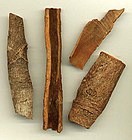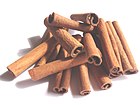Note: This is a project under development. The articles on this wiki are just being initiated and broadly incomplete. You can Help creating new pages.
Difference between revisions of "Cinnamomum cassia - Tamalpatra"
(→Habit) |
|||
| (9 intermediate revisions by 2 users not shown) | |||
| Line 1: | Line 1: | ||
| − | [[File: | + | [[File:Cinnamomum cassia Leaf.jpg|thumb|right]] |
| + | |||
'''Cassia cinnamon''' is a type of cinnamon prepared from the dried inner bark of an evergreen tree that grows in areas of southeastern Asia. | '''Cassia cinnamon''' is a type of cinnamon prepared from the dried inner bark of an evergreen tree that grows in areas of southeastern Asia. | ||
| − | |||
==Uses== | ==Uses== | ||
{{Uses|Diabetes}}, {{Uses|Gastric problem}}, {{Uses|Stomach spasms}}, {{Uses|Nausea}}, {{Uses|Vomiting}}, {{Uses|Infections}}, {{Uses|Common cold}}, {{Uses|Diarrhea}}, {{Uses|Loss of appetite}}, {{Uses|Hernia}}, {{Uses|Bed wetting}}, {{Uses|Joint pain}}, {{Uses|Menopausal symptoms}}, {{Uses|Cramps}}, {{Uses|Kidney disorders}}, {{Uses|Chest pain}}, {{Uses|Abortions}}, {{Uses|Menstrual problems}} | {{Uses|Diabetes}}, {{Uses|Gastric problem}}, {{Uses|Stomach spasms}}, {{Uses|Nausea}}, {{Uses|Vomiting}}, {{Uses|Infections}}, {{Uses|Common cold}}, {{Uses|Diarrhea}}, {{Uses|Loss of appetite}}, {{Uses|Hernia}}, {{Uses|Bed wetting}}, {{Uses|Joint pain}}, {{Uses|Menopausal symptoms}}, {{Uses|Cramps}}, {{Uses|Kidney disorders}}, {{Uses|Chest pain}}, {{Uses|Abortions}}, {{Uses|Menstrual problems}} | ||
| Line 9: | Line 9: | ||
==Chemical Composition== | ==Chemical Composition== | ||
| − | Phenols (6%), Isoeugenol (2%), Chavicol, Ethylgaiacol, Aromatic aldehyde, Cinnamaldehyde (75-85%), Benzaldehyde<ref name="chemical composition"/> | + | Phenols (6%), Isoeugenol (2%), Chavicol, Ethylgaiacol, Aromatic aldehyde, Cinnamaldehyde (75-85%), Benzaldehyde.<ref name="chemical composition"/> |
==Common names== | ==Common names== | ||
| − | {{Common names|kn=Tamalapatra|ml=|sa=|ta=|te=|hi= | + | {{Common names|kn=Tamalapatra|ml=|sa=|ta=|te=|hi=Tezpath|en=Cinnamomum cassia}} |
==Properties== | ==Properties== | ||
| Line 35: | Line 35: | ||
==Identification== | ==Identification== | ||
===Leaf=== | ===Leaf=== | ||
| − | {{Leaf|Simple| | + | {{Leaf|Simple|Opposite|Petiole 8-20 mm, stout, glabrous, slightly grooved above}}<ref name="Leaf"/> |
===Flower=== | ===Flower=== | ||
| Line 41: | Line 41: | ||
===Fruit=== | ===Fruit=== | ||
| − | {{Fruit| | + | {{Fruit|Berry|1-2 cm|Ellipsoid to oblong-ovoid, dark purple, surrounded by the enlarged perianth||2-4}} |
===Other features=== | ===Other features=== | ||
==List of Ayurvedic medicine in which the herb is used== | ==List of Ayurvedic medicine in which the herb is used== | ||
| − | |||
==Where to get the saplings== | ==Where to get the saplings== | ||
| Line 70: | Line 69: | ||
<references> | <references> | ||
| − | <ref name="chemical composition">[http://www.globinmed.com/index.php?option=com_content&view=article&id=82984:cinnamomum-cassia&Itemid=145b | + | <ref name="chemical composition">[http://www.globinmed.com/index.php?option=com_content&view=article&id=82984:cinnamomum-cassia&Itemid=145b Chemical Constituents]</ref> |
| − | <ref name="Leaf">[http://eol.org/pages/490672/details | + | <ref name="Leaf">[http://eol.org/pages/490672/details Diagnostic Description]</ref> |
| − | <ref name="How to plant/cultivate">[http://tropical.theferns.info/viewtropical.php?id=Cinnamomum+cassia | + | <ref name="How to plant/cultivate">[http://tropical.theferns.info/viewtropical.php?id=Cinnamomum+cassia Cultivation Details]</ref> |
</references> | </references> | ||
| Line 82: | Line 81: | ||
* [https://www.organicfacts.net/health-benefits/essential-oils/health-benefits-of-cassia-essential-oil.html Benefits Of Cassia on organic facts] | * [https://www.organicfacts.net/health-benefits/essential-oils/health-benefits-of-cassia-essential-oil.html Benefits Of Cassia on organic facts] | ||
[[Category:Herbs]] | [[Category:Herbs]] | ||
| + | [[Category:Ayurvedic herbs that don't have flower, fruit and leaf photos]] | ||
| + | [[Category:Ayurvedic herbs that don't have seed photos]] | ||
| + | [[Category:Lauraceae]] | ||
Latest revision as of 17:45, 6 October 2020
Cassia cinnamon is a type of cinnamon prepared from the dried inner bark of an evergreen tree that grows in areas of southeastern Asia.
Contents
- 1 Uses
- 2 Parts Used
- 3 Chemical Composition
- 4 Common names
- 5 Properties
- 6 Habit
- 7 Identification
- 8 List of Ayurvedic medicine in which the herb is used
- 9 Where to get the saplings
- 10 Mode of Propagation
- 11 How to plant/cultivate
- 12 Commonly seen growing in areas
- 13 Photo Gallery
- 14 References
- 15 External Links
Uses
Diabetes, Gastric problem, Stomach spasms, Nausea, Vomiting, Infections, Common cold, Diarrhea, Loss of appetite, Hernia, Bed wetting, Joint pain, Menopausal symptoms, Cramps, Kidney disorders, Chest pain, Abortions, Menstrual problems
Parts Used
Chemical Composition
Phenols (6%), Isoeugenol (2%), Chavicol, Ethylgaiacol, Aromatic aldehyde, Cinnamaldehyde (75-85%), Benzaldehyde.[1]
Common names
| Language | Common name |
|---|---|
| Kannada | Tamalapatra |
| Hindi | Tezpath |
| Malayalam | |
| Tamil | |
| Telugu | |
| Marathi | NA |
| Gujarathi | NA |
| Punjabi | NA |
| Kashmiri | NA |
| Sanskrit | |
| English | Cinnamomum cassia |
Properties
Reference: Dravya - Substance, Rasa - Taste, Guna - Qualities, Veerya - Potency, Vipaka - Post-digesion effect, Karma - Pharmacological activity, Prabhava - Therepeutics.
Dravya
Rasa
Guna
Veerya
Vipaka
Karma
Prabhava
Habit
Identification
Leaf
| Kind | Shape | Feature |
|---|---|---|
| Simple | Opposite | Petiole 8-20 mm, stout, glabrous, slightly grooved above |
Flower
| Type | Size | Color and composition | Stamen | More information |
|---|---|---|---|---|
| Bisexual | 7 mm long | Yellow | 9 | Flowers are in terminal and axillary |
Fruit
| Type | Size | Mass | Appearance | Seeds | More information |
|---|---|---|---|---|---|
| Berry | 1-2 cm | Ellipsoid to oblong-ovoid, dark purple, surrounded by the enlarged perianth | 2-4 | {{{6}}} |
Other features
List of Ayurvedic medicine in which the herb is used
Where to get the saplings
Mode of Propagation
How to plant/cultivate
A plant of the lowland tropics and subtropics, where it is found at elevations up to 500 metres. It grows best in areas where annual daytime temperatures are within the range 15 - 32°c, but can tolerate 10 - 38°c[3]
Commonly seen growing in areas
At primary forest, At secondary forest.
Photo Gallery
References
External Links
- Ayurvedic Herbs known to be helpful to treat Diabetes
- Ayurvedic Herbs known to be helpful to treat Gastric problem
- Ayurvedic Herbs known to be helpful to treat Stomach spasms
- Ayurvedic Herbs known to be helpful to treat Nausea
- Ayurvedic Herbs known to be helpful to treat Vomiting
- Ayurvedic Herbs known to be helpful to treat Infections
- Ayurvedic Herbs known to be helpful to treat Common cold
- Ayurvedic Herbs known to be helpful to treat Diarrhea
- Ayurvedic Herbs known to be helpful to treat Loss of appetite
- Ayurvedic Herbs known to be helpful to treat Hernia
- Ayurvedic Herbs known to be helpful to treat Bed wetting
- Ayurvedic Herbs known to be helpful to treat Joint pain
- Ayurvedic Herbs known to be helpful to treat Menopausal symptoms
- Ayurvedic Herbs known to be helpful to treat Cramps
- Ayurvedic Herbs known to be helpful to treat Kidney disorders
- Ayurvedic Herbs known to be helpful to treat Chest pain
- Ayurvedic Herbs known to be helpful to treat Abortions
- Ayurvedic Herbs known to be helpful to treat Menstrual problems
- Herbs with Barks used in medicine
- Herbs with Twigs used in medicine
- Herbs with Leaves used in medicine
- Herbs with common name in Kannada
- Herbs with common name in Hindi
- Herbs with common name in English
- Habit - Evergreen tree
- Index of Plants which can be propagated by Seeds
- Index of Plants which can be propagated by Cuttings
- Herbs that are commonly seen in the region of At primary forest
- Herbs that are commonly seen in the region of At secondary forest
- Herbs
- Ayurvedic herbs that don't have flower, fruit and leaf photos
- Ayurvedic herbs that don't have seed photos
- Lauraceae





